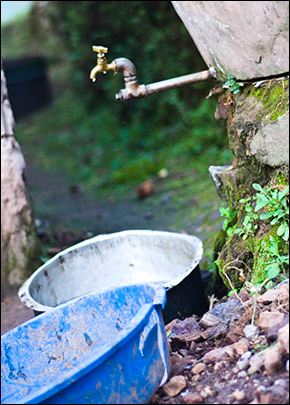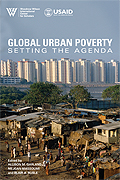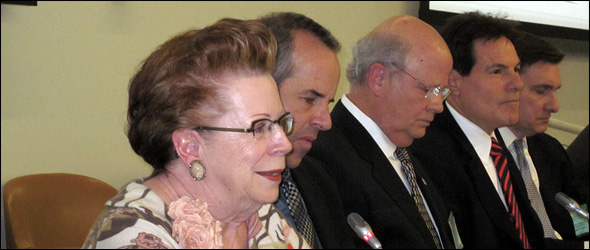Sanitation and drinking water: is the world on track?
New UNICEF and the World Health Organization report: despite global progress, sanitation remains a major health concern throughout the developing world.
By C.T. Pope, Circle of Blue
UPDATE: This article was updated on May 26, 2009.
When I first arrived in Uganda’s capital city of Kampala, I spent the night in a posh upscale suburban household. Running water, cable TV, and electricity: they were all there. But, as I traveled south the next day, toward the rural lifestyle that I would live for six months, Western conveniences began vanishing.
I remember the big power lines ending first, then the smaller ones disappearing. The two-lane “highway” slowly transitioned from bad to worse, and finally turned to dirt. When we stopped for a toilet break, we stopped in a field. The men and women scattered out among the Ankole cattle to do their business — I understood for the first time why all the women wore skirts.
When I finally reached my destination — a remote village on the edge of the Bwindi Impenetrable Forest — late that night, the only lights I saw came from the one shop in town that could afford solar panels. There was no electricity and no running water. I would live there as a researcher and learn the value of clean water for the first time in my life.
Bucket-baths, pit-latrines, and rainwater tanks all became new words in my everyday vocabulary. Water and sanitation became personal problems; keeping clean and staying hydrated were now time-consuming tasks. Eventually I would return to the West, however, and leave a world without running water behind.
Clean water and basic sanitation facilities, often taken for granted in the West, are something that billions worldwide do not have and cannot afford. Improving access to these basic necessities is the focus of a new report by UNICEF and the World Health Organization’s Joint Monitoring Programme for Water Supply and Sanitation (JMP).
The report comes halfway through the UN’s International Year of Sanitation, and catalogues the world’s progress toward reaching the Millennium Development Goals (MDGs) set in 2000, of halving the total number of people without toilet facilities and clean drinking water by 2015.
My first hand experiences with unimproved and limited water supplies and “open defecation” (relieving oneself in open/unprotected areas) by the roadside, are but a drop in the bucket compared to the scope and scale of the world water crisis highlighted in the report.
According to the JMP, for example, open defecation is still common for nearly 1.2 billion people worldwide — the majority living in rural areas of Asia and Africa. And it poses a major health risk both to those who practice it and to those who live in or near the communities where it is prevalent.
We know that about 5000 children die everyday from diarrheal disease and almost 90 percent of that diarrheal disease is caused by inadequate water and sanitation. In villages throughout sub-Saharan Africa and southern Asia, defecation is often practiced without even the most basic facilities, the report says. Infrastructure for sanitation is non-existent, and villagers must relieve themselves wherever they can: in rivers and streams, in areas where other household refuse is stored, or simply behind their dwellings in specific locations.
While the number of people practicing open defecation has dropped 6 percent since 1990, according to the JMP, more progress is needed to meet the MDG target for sanitation.
Open defecation remains but one piece in the complex puzzle of the global water and sanitation crisis, however. Clarissa Brocklehurst, chief of Water and Environmental Sanitation at UNICEF, talked to me during a press conference I attended by phone about the effects of contamination, water shortages, and other factors relevant to human health.
“We know that about 5000 children die everyday from diarrheal disease and almost 90 percent of that diarrheal disease is caused by inadequate water and sanitation,” she explained. “We can’t combat child mortality and under-nutrition unless we do something about diarrhea, and we can’t combat diarrhea, unless we do something about water and sanitation.”
The problem of water and sanitation also underlines class struggles and women’s rights issues faced by many: only 28 percent of the world’s poorest have access to basic toilet facilities, and the burden of collecting and managing water falls largely on the shoulders of the mothers and daughters of rural Africa and Asia.
“[Women] have to make multiple journeys every day to collect water from remote sources which are often unsafe,” said Jamie Bartram, the coordinator for Water, Sanitation, and Health, for WHO. “If it isn’t unsafe where the water is collected, the water is unsafe by the time it gets home,” he added.
In Uganda, where I worked and lived, nearly 43 percent of rural women travel more than 30 minutes from their homes to collect drinking water. Families generally carry one or two 20-liter containers to watering holes, streams, and rivers to collect the day’s water.
Traveling these distances limits their individual water use often to less than 15 liters per day, below the standards set by WHO to meet basic human needs. In comparison, the average American or European consumes somewhere between 300-400 liters of water per day.
Progress is being made, however, toward reducing the number of people who do not have access to safe drinking water. The JMP anticipates that the world is on track to meet the MDG target for safe drinking water, with the number of people without an improved drinking water source falling below one billion for the first time ever. But more progress needs to be made on the sanitation front.
“The truth is that the sanitation MDG target has been missed, we need now to be looking…beyond 2015. Renewed commitment to go beyond the progress toward the MDGs and actually achieve the vision of the MDGs and go beyond it toward universal progress,” Bartram explained.
He went on to express the urgency and necessity of achieving these goals. “Almost 10 percent of all disease worldwide could be prevented by better management of [water and sanitation] services and resources; not only could it be prevented, but the benefits can be valued at more than the actual costs,” he said.
Circle of Blue’s east coast correspondent based in New York. He specializes on water conflict and the water-food-energy nexus. He previously worked as a political risk analyst covering equatorial Africa’s energy sector, and sustainable development in sub-Saharan Africa. Contact: Cody.Pope@circleofblue.org









When you visit some of the very poor rural communities during midday to afternoon, you find that some ladies are sitting or sleeping, they are dirty and their clothes are also dirty. They will tell you that they are tired because they had to fetch water from very far, more than 1km away, sometimes in 25L plastic containers strapped on their backs or on their heads. They cannot afford to fetch extra to wash up or do extra laundry because its just too taxing. The 50L which they can afford to fetch per day is just enough for cooking and washing the plates and pots afterwards.
And we wonder why rural folk in these unsevrved environmnets are always dirty and scruffy. To them cleaning up is just luxury they cannot afford to indulge in, where the quantity of useable water is limited by the sheer distance to source.
I would like to start receiving some information on Water and Sanitation
Good report, but I noticed a mistake, and a fairly large one at that.
It is when you say “Progress is being made, however, toward reducing the number of people who have access to safe drinking water.”
This is saying that progress is being made to reduce the number of people who actually DO have safe water, when what you really mean is progress is being made to reduce the number of people who do NOT have access to safe drinking water.
At least I hope that’s what you mean. No lol just kidding, but seriously, that should be fixed.
Again, good report
Thanks Nate. I’ve fixed that error.